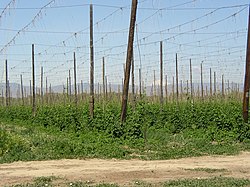Hops
From Wikipedia, the free encyclopedia
![Hop umbel[citation needed] (branched floral structure resembling nested-inverted umbrellas) in a Hallertau hop yard](http://upload.wikimedia.org/wikipedia/commons/thumb/e/e8/Hopfendolde-mit-hopfengarten.jpg/250px-Hopfendolde-mit-hopfengarten.jpg)
Hops are a flower used primarily as a flavouring and stability agent in beer, as well as in herbal medicine. The first documented use in beer is from the eleventh century. Hops come from the flowers of Humulus lupulus, originally named by Pliny the Elder in his Naturalis Historia,[1] and contain several characteristics very favourable to beer: (a) hops contribute a bitterness that balances the sweetness of the malt, (b) hops can contribute aromas that are flowery, citrus, fruity or herbal, and (c) hops have an antibiotic effect that favors the activity of brewer's yeast over less desirable microorganisms. While hop plants are grown by farmers all around the world in many different varieties, there is no major commercial use for hops other than in beer, although hops are an ingredient in Julmust, a carbonated beverage similar to cola soda that is popular in Sweden during December. The hop plant is a vigorous climber, usually grown up strings in a field called a hop garden or hop yard.
Contents[hide] |
[edit] History
The first documented instance of hop cultivation was in 736, in the Hallertau region of present-day Germany (which, in 2006, had more hop-growing area than any other country in the world)[4], although the first mention of the use of hops in brewing was in 1079.[2] Hops were introduced to British beers in the early 15th century, and hop cultivation began in the present-day United States in 1629.
Until mechanisation (in the late 1960s for the UK), the need for massed labour at harvest time meant hop-growing had a big social impact. Many of those hop picking in Kent were Eastenders, for whom the annual migration meant not just money in the family pocket but a welcome break from the grime and smoke of London. Whole families would come down on special trains and live in hoppers' huts and gradients for most of September, even the smallest children helping in the fields.[3]
Today, the principal production centres for the UK are in Kent (which produces Kent Golding hops) and Worcestershire.[4] [5] Other important production areas include Washington's Yakima Valley and Oregon's Willamette Valley in the USA. Belgium, Germany, and the Czech Republic are also important centers of the hop industry.
[edit] Brewing

Hop resins are composed of two main acids: alpha and beta acids.
Alpha acids have a mild antibiotic/bacteriostatic effect against Gram-positive bacteria, and favour the exclusive activity of brewing yeast in the fermentation of beer.
Beta acids do not isomerise during the boil of wort, and have a negligible effect on beer flavour. Instead they contribute to beer's bitter aroma, and high beta acid hop varieties are often added at the end of the wort boil for aroma. Beta acids oxidize and oxidized beta acids form sulfur compounds such as DMS (dimethyl sulfide) that can give beer off-flavours of rotten vegetables or cooked corn.
The flavour imparted by hops varies by type and use: hops boiled with the beer (known as "bittering hops") produce bitterness, while hops added to beer later impart some degree of "hop flavour" (if during the final 10 minutes of boil) or "hop aroma" (if during the final 3 minutes, or less, of boil) and a lesser degree of bitterness. Adding hops after the wort has cooled and the beer has fermented is known as "dry hopping", and adds hop aroma, but no bitterness. The degree of bitterness imparted by hops depends on the degree to which otherwise insoluble alpha acids (AAs) are isomerized during the boil, and the impact of a given amount of hops is specified in International Bitterness Units. Unboiled hops are only mildly bitter.
Flavours and aromas are described appreciatively using terms which include "grassy", "floral", "citrus", "spicy", and "earthy". Most of the common commercial lagers have fairly low hop influence, while true pilseners should have noticeable noble hop aroma and certain ales (particularly the highly-hopped style known as India Pale Ale, or IPA) can have high levels of bitterness.

No hay comentarios:
Publicar un comentario